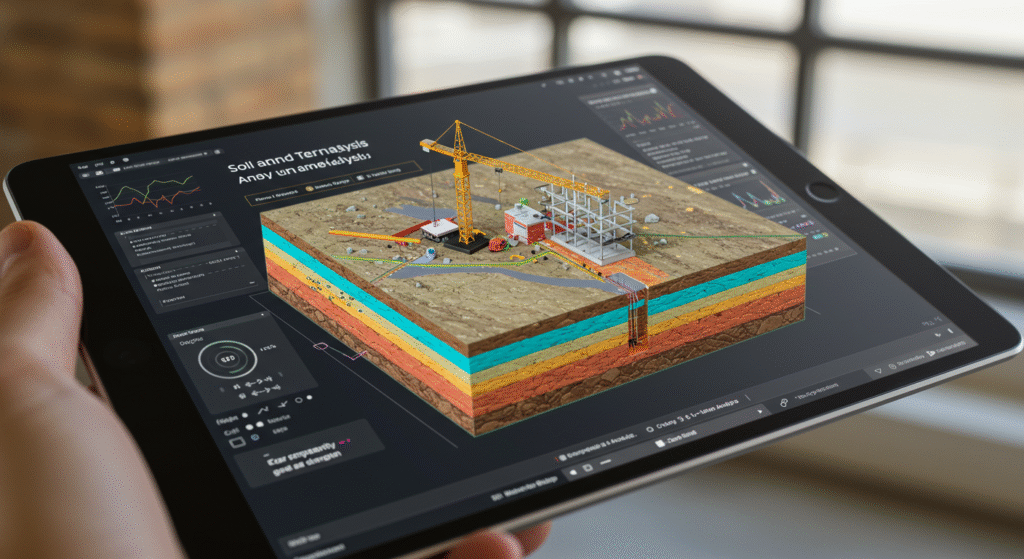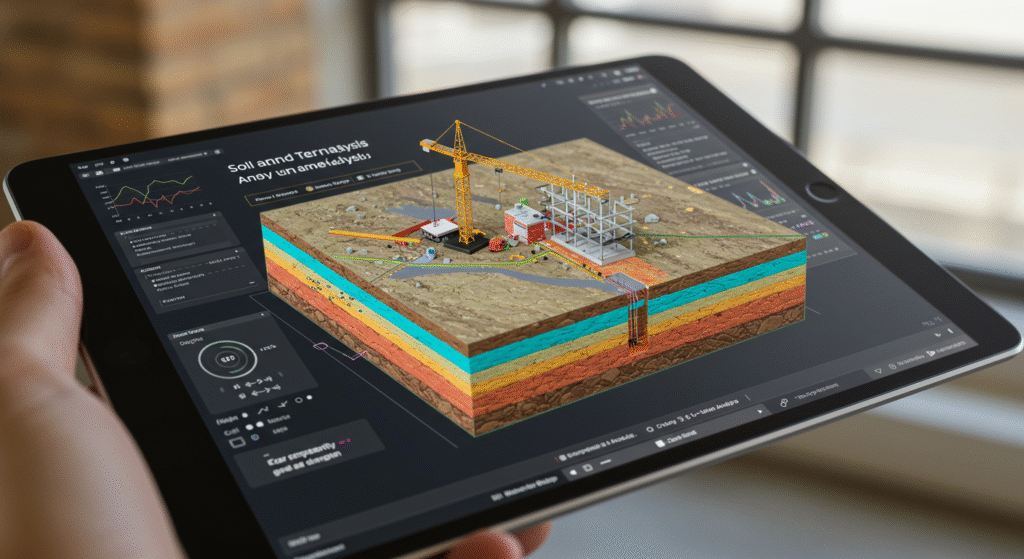Soil and Terrain Analysis in Civil Engineering

Table of Contents
- Introduction to Soil and Terrain Analysis
- 1.1. Importance of Soil and Terrain Analysis
- 1.2. Role in Civil Engineering Projects
- 1.3. Historical Development
- Soil Mechanics and Properties
- 2.1. Basic Soil Properties
- 2.2. Soil Classification Systems
- 2.3. Stress-Strain Behavior of Soils
- Terrain Analysis and Mapping
- 3.1. Topographic Mapping
- 3.2. Geomorphological Studies
- 3.3. Remote Sensing and GIS Applications
- Site Investigation and Testing
- 4.1. Site Investigation Techniques
- 4.2. In-Situ Testing Methods
- 4.3. Laboratory Testing of Soil Samples
- Applications in Civil Engineering Projects
- 5.1. Foundation Design
- 5.2. Slope Stability Analysis
- 5.3. Pavement and Road Construction
- 5.4. Tunnel and Underground Structures
- Challenges and Considerations
- 6.1. Geological Hazards
- 6.2. Environmental Impact
- 6.3. Cost and Time Constraints
- Advanced Techniques and Technologies
- 7.1. Geophysical Exploration
- 7.2. Advanced Laboratory Testing
- 7.3. Numerical Modeling and Simulation
- Case Studies and Real-World Applications
- 8.1. Successful Projects
- 8.2. Lessons from Failures
- 8.3. Industry-Specific Applications
- Regulations and Standards
- 9.1. International Building Codes
- 9.2. Local and Regional Regulations
- 9.3. Compliance and Certification
- Education and Training
- 10.1. Academic Programs
- 10.2. Professional Certifications
- 10.3. Continuing Education
- Conclusion
- 11.1. Summary of Key Points
- 11.2. The Evolving Role of Soil and Terrain Analysis
- 11.3. Encouragement for Future Professionals
1. Introduction to Soil and Terrain Analysis

1.1. Importance of Soil and Terrain Analysis
Soil and terrain analysis is crucial in civil engineering as it provides essential insights into the physical properties of the ground, which are vital for the design and construction of structures. Understanding the soil and terrain allows engineers to assess the stability and suitability of the land for various projects, ensuring safety and durability.
1.2. Role in Civil Engineering Projects
In civil engineering, soil and terrain analysis is integral to numerous projects, including foundation design, road construction, and tunnel engineering. It helps determine the bearing capacity of the soil, identify potential geological hazards, and select appropriate construction materials and techniques.
1.3. Historical Development
The importance of soil and terrain analysis has been recognized since ancient times, with early engineers using rudimentary methods to assess land for construction. Over the centuries, the field has evolved with advancements in technology and scientific understanding, leading to more sophisticated methods of analysis.
2. Soil Mechanics and Properties
2.1. Basic Soil Properties
Soil properties such as texture, density, plasticity, and permeability are fundamental to understanding its behavior. These properties influence how soil reacts under different loads and environmental conditions, making them critical for engineering applications.
2.2. Soil Classification Systems
Soil classification systems, like the Unified Soil Classification System (USCS), help categorize soils based on their properties. This classification aids in predicting soil behavior and selecting appropriate construction methods.
2.3. Stress-Strain Behavior of Soils
Understanding the stress-strain behavior of soils is essential for predicting how they will respond to loads. This knowledge is crucial for designing stable foundations and other structures that rely on soil support.
3. Terrain Analysis and Mapping

3.1. Topographic Mapping
Topographic maps provide detailed information about the shape and features of the land. They are essential for identifying slopes, drainage patterns, and other factors that influence construction.
3.2. Geomorphological Studies
Geomorphological studies examine the physical features of the landscape, including landforms and geological formations. This information helps assess the stability of the terrain and identify potential hazards.
3.3. Remote Sensing and GIS Applications
Remote sensing and Geographic Information Systems (GIS) offer advanced tools for terrain analysis. These technologies allow for the collection and analysis of large-scale data, enabling engineers to map and study the terrain with greater precision.
4. Site Investigation and Testing
4.1. Site Investigation Techniques
Site investigation involves gathering data about the subsurface conditions of a site. Techniques include soil sampling, borehole drilling, and geophysical surveys, which provide critical information for design and construction.
4.2. In-Situ Testing Methods
In-situ testing methods, such as the Standard Penetration Test (SPT) and Cone Penetration Test (CPT), are conducted on-site to assess soil properties and behavior.
4.3. Laboratory Testing of Soil Samples
Laboratory testing of soil samples involves various tests to determine properties like shear strength, compressibility, and permeability. These tests provide detailed information necessary for engineering design.
5. Applications in Civil Engineering Projects

5.1. Foundation Design
Soil and terrain analysis is crucial for foundation design, ensuring that the foundation can support the weight of the structure safely. Different soil types require different foundation solutions, such as shallow foundations or deep foundations.
5.2. Slope Stability Analysis
Slope stability analysis is essential for preventing landslides and ensuring the stability of slopes in construction projects. Engineers use soil properties and terrain data to assess the risk of slope failure and design appropriate stabilization measures.
5.3. Pavement and Road Construction
The design of pavements and roads relies heavily on soil and terrain analysis. The subgrade soil must be able to support the weight of traffic without excessive deformation, requiring careful analysis and selection of materials.
5.4. Tunnel and Underground Structures
Tunnel engineering requires detailed soil and terrain analysis to assess the geological conditions and design safe and stable underground structures. This involves understanding the behavior of different soil types under various loads and conditions.
6. Challenges and Considerations
6.1. Geological Hazards
Geological hazards such as earthquakes, landslides, and subsidence pose significant challenges in civil engineering projects. Soil and terrain analysis helps identify and mitigate these risks.
6.2. Environmental Impact
Construction projects can have environmental impacts, such as soil erosion and groundwater contamination. Soil and terrain analysis helps assess and mitigate these effects, promoting sustainable construction practices.
6.3. Cost and Time Constraints
Managing cost and time constraints is critical in civil engineering projects. Soil and terrain analysis helps optimize resource use and avoid costly delays by providing accurate data for design and construction planning.
7. Advanced Techniques and Technologies

7.1. Geophysical Exploration
Geophysical exploration techniques, such as seismic and electrical resistivity tomography, provide non-invasive methods for subsurface investigation, offering detailed information about soil and rock layers.
7.2. Advanced Laboratory Testing
Advanced laboratory testing methods, including triaxial testing and cyclic loading tests, provide detailed insights into soil behavior under various conditions, enhancing the accuracy of engineering designs.
7.3. Numerical Modeling and Simulation
Numerical modeling and simulation tools allow engineers to simulate soil behavior under different loads and conditions, enabling the optimization of designs and the prediction of long-term performance.
8. Case Studies and Real-World Applications
8.1. Successful Projects
Case studies of successful projects demonstrate the effectiveness of soil and terrain analysis in ensuring the stability and safety of structures. Examples include the construction of the Burj Khalifa and the Channel Tunnel.
8.2. Lessons from Failures
Analyzing failures, such as the Leaning Tower of Pisa, highlights the importance of thorough soil and terrain analysis in preventing structural issues and ensuring long-term stability.
8.3. Industry-Specific Applications
Soil and terrain analysis is applied across various industries, from transportation to energy, each with its own unique challenges and requirements. Understanding these applications provides insights into the versatility of soil and terrain analysis.
9. Regulations and Standards

9.1. International Building Codes
International building codes and standards, such as the International Building Code (IBC), provide guidelines for soil and terrain analysis in construction, ensuring compliance with safety and design standards.
9.2. Local and Regional Regulations
Local and regional regulations may vary, requiring engineers to adapt their practices to meet specific requirements. Compliance with these regulations is essential for legal and safety reasons.
9.3. Compliance and Certification
Ensuring compliance with regulations and obtaining necessary certifications is crucial for the successful completion of civil engineering projects. This involves adhering to standards and undergoing regular audits and inspections.
10. Education and Training
10.1. Academic Programs
Academic programs in civil engineering and geotechnical engineering provide the foundational knowledge and skills necessary for soil and terrain analysis. These programs typically include coursework in soil mechanics, geology, and surveying.
10.2. Professional Certifications
Professional certifications, such as the Professional Engineer (PE) license, demonstrate expertise in soil and terrain analysis. These certifications require passing exams and completing continuing education requirements.
10.3. Continuing Education
Continuing education is essential for professionals to stay current with the latest techniques, technologies, and regulations in soil and terrain analysis. This may involve attending workshops, conferences, and online courses.
11. Conclusion

11.1. Summary of Key Points
Soil and terrain analysis is a fundamental aspect of civil engineering, providing critical insights into the physical properties of the ground and its behavior under various conditions. By understanding soil mechanics, employing advanced techniques, and adhering to regulations, engineers can design and construct safe and durable structures.
11.2. The Evolving Role of Soil and Terrain Analysis
The role of soil and terrain analysis in civil engineering is continuously evolving, driven by technological advancements and the increasing complexity of construction projects. As new challenges emerge, the field must adapt to provide innovative solutions.
11.3. Encouragement for Future Professionals
For those interested in pursuing a career in soil and terrain analysis, the field offers rewarding opportunities to contribute to the development of infrastructure and ensure the safety of communities. By pursuing education, gaining practical experience, and staying current with industry developments, future professionals can make a meaningful impact in this vital area of civil engineering.
- https://worldcivilsociety.com/transportation-network-engineering/
- https://worldcivilsociety.com/skyscraper-design-engineering/
- https://worldcivilsociety.com/engineering-innovation-for-communities/
- https://worldcivilsociety.com/construction-project-management/
- https://worldcivilsociety.com/construction-cost-estimation/
Pingback: Civil Engineering in Project Management
Pingback: The Role of Engineers in Society: A Comprehensive Overview